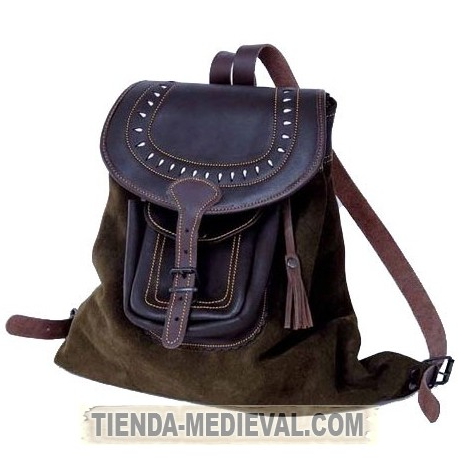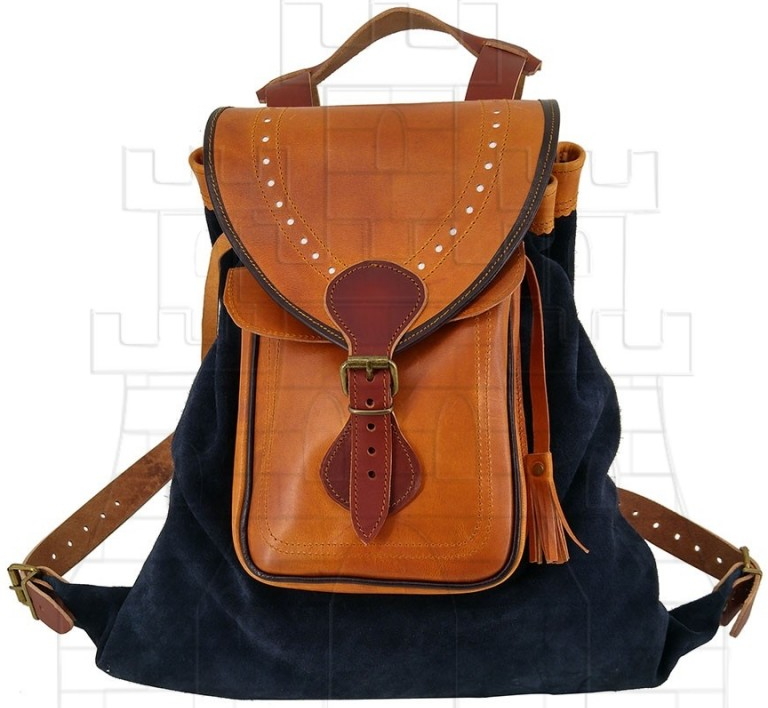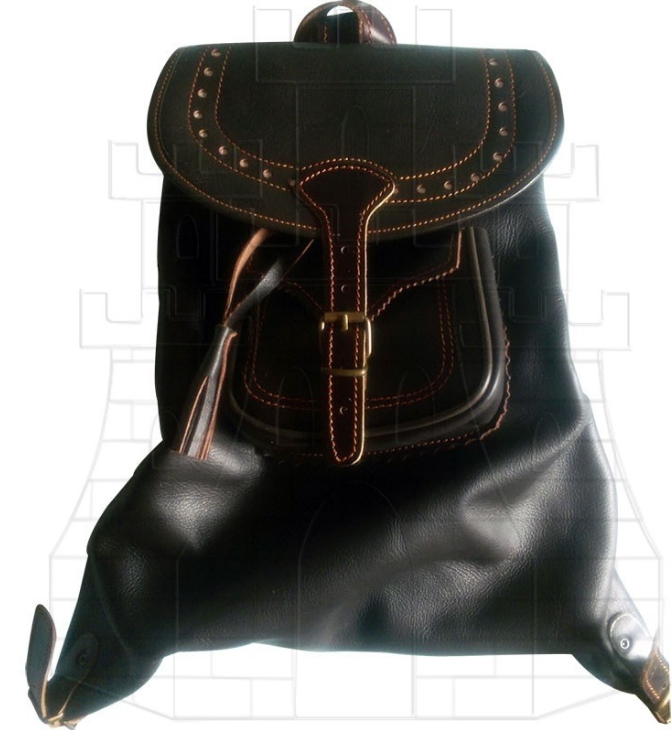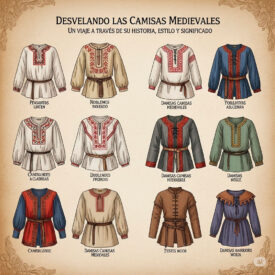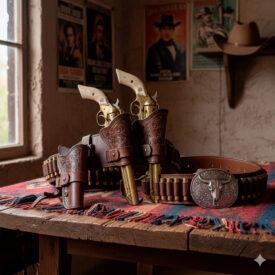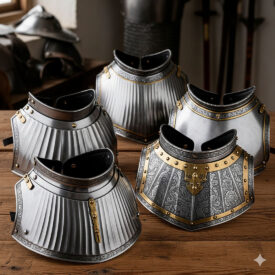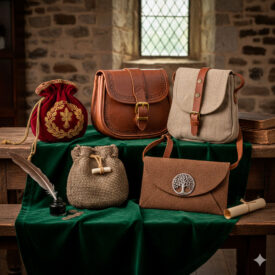Medieval backpacks combine tradition and functionality: practical pieces that tell stories. If you are interested in historical reenactment, medieval markets, or simply looking for a backpack with character and durability, here is a complete guide to understanding, choosing, and caring for an authentic or past-inspired medieval backpack.
What is a medieval backpack and why is it still relevant?
A backpack is luggage carried on the back with two straps over the shoulders; it is also known as a satchel or haversack. In the medieval world, this object was not just for carrying belongings: it was an everyday item full of ingenious solutions for transporting and protecting essentials.
Its continued relevance is explained by the comfort of carrying the load on the shoulders and the versatility of traditional materials — such as leather, hide, or resistant fabrics — which in many cases still offer an excellent weight-durability ratio and timeless aesthetics.
Brief history: from prehistoric haversack to medieval backpack
The origin of the backpack dates back to prehistory: humans needed to transport belongings on their backs and developed simple solutions with hides, barks, and vegetable fibers. Over time, and especially from the Middle Ages onwards, the need for mobility — merchants, soldiers, pilgrims — spurred the diversification of forms and materials.
Wars and mass displacements of people contributed to improving closures, straps, and reinforcements. The result is pieces we now call medieval backpacks or haversacks: practical constructions, often hand-stitched, with drawstring closures, reinforced flaps, and simple hardware.
In historical reenactment contexts, material and technique fidelity are valued; in urban or adventure use, the medieval aesthetic combined with contemporary solutions for comfort is appreciated.
Anatomy and materials: what to look for in a medieval backpack
Knowing the anatomy of a medieval backpack helps you choose the right piece. The most common elements are:
- Body or sack: the main bag, usually made of leather, deer hide, or thick canvas.
- Lid or flap: protects from water and dust; in many designs, it is secured with straps or metal clasps.
- Straps: simple leather shoulder straps, sometimes padded or adjustable with knots or buckles.
- Reinforcements: stitching punctures, overlapping pieces, or patches that increase durability.
- Closures: drawstrings, toggles, buckles, or metal or wooden buttons.
Materials influence weight, resistance, and aesthetics. Traditionally tanned leather offers superior longevity and ages well, developing a patina. Soft hides like deer provide texture and an authentic look; waxed canvas can be lighter and more resistant to moisture in everyday use.
Types and formats: how medieval backpacks are classified
Medieval backpacks adapt to various functions. Here are some common formats:
- Simple haversack: bag with drawstring and flap, ideal for light transport.
- Backpack with flap and buckles: more secure design, good for daily use and reenactment.
- Cylindrical or harness backpack: for irregular loads; used by travelers and merchants.
- Combined bags: backpacks with exterior compartments or side bags for small items.
The choice of type depends on the use: for a medieval fair, a simple haversack might work; for trips or weekend activities, a model with a flap and more structure is advisable.
How to choose the perfect medieval backpack
Choosing involves balancing authenticity, comfort, and function. Consider:
- Purpose: historical reenactment, urban use, travel, or cultural merchandising.
- Size and capacity: measure what you usually carry: documents, water bottle, light clothing, small tools.
- Material: leather for aesthetics and durability; waxed fabric for lightness; hides for authenticity in reconstruction.
- Strapping: look for wide straps if you will be carrying weight; ergonomics make a difference.
- Finish and hardware: choose closures that are comfortable for you and match the style you are looking for.
If you participate in historical events, review the organizer’s rules regarding materials and finishes; if you are looking for a functional backpack for daily use, prioritize comfort and water resistance or leather treatments.
Maintenance and care: prolong the life of your backpack
Leather and hides require maintenance to preserve their properties and appearance. Some simple guidelines:
- Regular cleaning: remove dust with a dry cloth or soft brush.
- Leather conditioner: apply periodically to prevent dryness and cracks.
- Avoid prolonged moisture: dry the backpack at room temperature; do not use direct heat sources.
- Repairs: small loose seams or loose hardware should be fixed promptly to prevent them from worsening.
- Storage: keep in a ventilated, dark place, with support to prevent deformation.
With basic care, a quality medieval backpack can last for decades and improve its appearance with the patina of time.
Medieval backpack versus modern backpacks
Although modern backpacks incorporate technical materials (foams, ergonomic panels, waterproof synthetic fabrics), medieval backpacks have their own advantages: unique aesthetics, sustainability when natural materials are used, and a sense of authenticity that many value.
For long trips or sporting activities, you might prefer a technical backpack. For fairs, reenactments, or daily use with style, a well-made medieval backpack offers character and sufficient functionality for moderate loads.
Recommended uses and combinations with medieval attire
A well-chosen medieval backpack integrates with historical attire: over a tunic, over a tabard, or outside a belt. For recreation, pay attention to proportions: a backpack that is too large breaks visual harmony, while a very small one is impractical.
At events, you can complement it with belts, waist bags, or small saddlebags. For a daily look, coordinate tones and textures with boots, belts, and accessories to maintain aesthetic coherence.
Measurements and capacities: how to calculate what you need
Medieval backpacks do not have modern standard measurements. A practical rule: define the items you usually carry and add 20-30% extra space for comfort. Examples:
- Light urban use: 8–12 liters (documents, wallet, small bottle).
- Weekends or market: 15–25 liters (light clothing, food, small tools).
- Short trips: 25–35 liters (more structure and reinforcement in straps).
Also evaluate access: a wide opening facilitates taking out objects, while tighter closures better protect the contents.
Personalization and restoration: bringing your backpack to life
Personalizing a medieval backpack is common: adding patches, hardware, internal pockets, or linings. In restorations, professionals recommend using compatible materials to avoid chemical reactions and maintain aesthetics.
If you do not want to alter the piece, you can add internal sleeves or modular bags that do not affect the exterior.
Where to buy medieval backpacks
To acquire quality medieval backpacks with a guarantee, our recommendation is to visit our online store: Tienda-Medieval. There you will find models in leather, hide, and canvas, with options designed for historical reenactment and everyday use.
Buying from the store allows access to detailed descriptions, measurements, and photographs that will help you choose the model that best suits your needs. In addition, we offer information on maintenance and compatibility with historical attire.
Final tips for choosing wisely
Prioritize functionality without losing sight of aesthetic coherence. Check seams and hardware, ask for clear measurements, and value the store’s return policies. If you are in doubt between two models, choose the one that offers better strap support and capacity according to your habits.
Medieval backpacks are more than an accessory: they are objects with history and personality. With proper care, they will accompany you for many years and, in addition, add character to your attire.
VIEW MEDIEVAL LEATHER BACKPACKS | VIEW OTHER MEDIEVAL LEATHER BAGS | VIEW BEAUTIFUL MEDIEVAL ACCESSORIES

